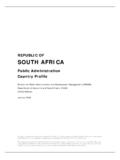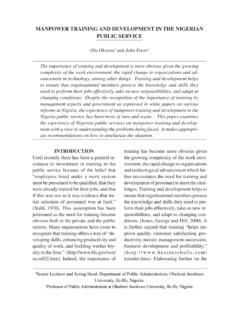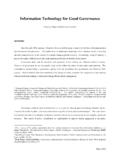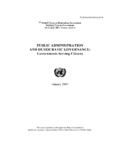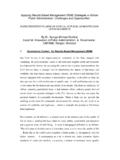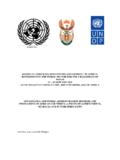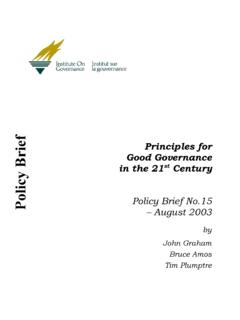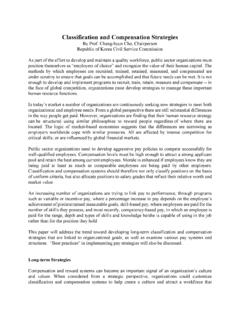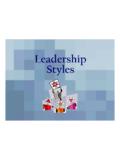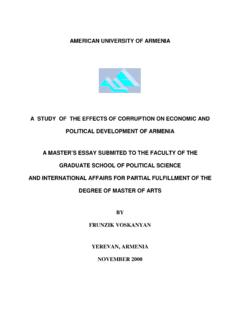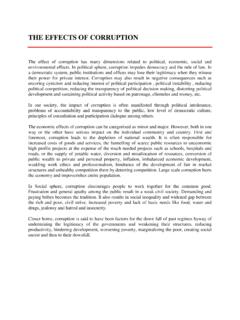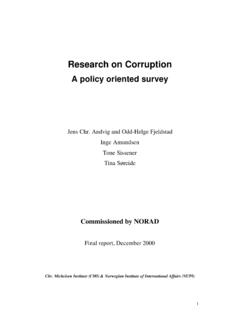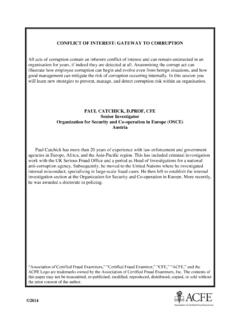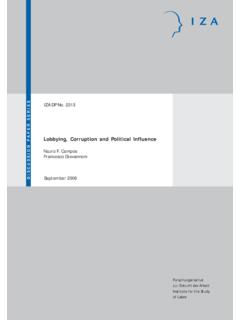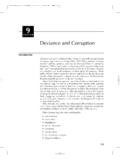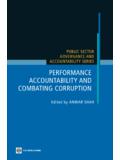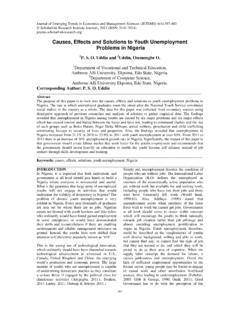Transcription of 1 CAUSES OF CORRUPTION IN PUBLIC SECTOR …
1 1 Alexandra Mills May 2012: CAUSES of CORRUPTION in PUBLIC SECTOR institutions and its impact on development CAUSES OF CORRUPTION IN PUBLIC SECTOR institutions AND ITS IMPACT ON DEVELOPMENT: TURNING WHAT WE KNOW INTO WHAT WE DO 1. BACKGROUND TO THIS PAPER It is a common convention for papers about CORRUPTION to start with a historical reference that emphasizes the longevity and resilience of CORRUPTION . Rather than refer to the wisdom of the ancient world or the words of a great statesman I will observe that convention by noting the historical context of this Expert Group Meeting on preventing CORRUPTION in the PUBLIC administration. The purpose of the meeting is to facilitate progress in CORRUPTION prevention, particularly in relation to institutional methods and practice, and to recommend the continuation or consideration of specific strategies for doing so. It is part of a process that isoften said to have begun with the so-called cancer of CORRUPTION speech by World Bank President James Wolfensohn in 1996.
2 By acknowledging the ubiquity of CORRUPTION , the lasting damage it can cause and the responsibility of powerful institutions to take action, that speech represented a turning point in the attitude of key international actors and licensed a systematic international effort against CORRUPTION that this meeting is part of. Since then CORRUPTION has been studied, classified, measured, defined and proscribed by policy makers and practitioners, theorists and researchers mostly in the disciplines of political science, economics, philosophy, PUBLIC administration and law enforcement. In an effort to come to grips with the nature of CORRUPTION much of the early anti- CORRUPTION activity produced research data, multilateral agreements, model laws, frameworks and strategies for prevention ultimately producing the OECD Anti-Bribery Convention and the United Nations Convention Against CORRUPTION . The Anti-Bribery Convention represented a change in approach by introducing the potential for very wide application, engaging locally enforceable policy levers and international obligations, and enabling monitoring of enforcement.
3 The United Nations Convention Against CORRUPTION (UNCAC) has applied the same attributes to a wider focus. Explicitly incorporating the implementation of prevention policy and mechanisms has encouraged wave of activity focused on the challenge of reducing or preventing the incidence of CORRUPTION particularly in the PUBLIC SECTOR environment. With that activity have come insights from a wider range of disciplines to contribute to our understanding of CORRUPTION . Social psychology, organizational theory, social theory, business ethics, criminology and behavioural economics, among others, all have something to offer the CORRUPTION prevention endeavour. 2 Alexandra Mills May 2012: CAUSES of CORRUPTION in PUBLIC SECTOR institutions and its impact on development This paper was prepared to assist the meeting in achieving its objectives with this history in mind and against this background. The first section is a brief overview of the consensus that has been reached on many conceptsused in the international anti- CORRUPTION discourseand the programs, mechanisms and resources that have been developed to give effect to international effort.
4 The next section discusses some practical challenges that present themselves in the current era of implementing these mechanisms. It points to the respective roles of legal frameworks, PUBLIC SECTOR institutions , human resources practices, information and communications technology (ICT) and the engagement of non-government actors. Finally the paper presents for discussion some suggestions for ways to build on the consensus and achievements obtained so far in order to meet those challenges in the future. This paper uses some examples from Australia, not only because of my familiarity with that context, but because it has a comparatively long and diverse experience of implementing anti- CORRUPTION policy across levels of government. 2. PREVENTING CORRUPTION IN PUBLIC ADMINISTRATION Prevention The common rhetoric of combating or fighting CORRUPTION conjures images of an enemy that can be defeated. Similarly theidea of CORRUPTION as a cancerous tumour encourages a belief that once found it can be surgically removed with no ill effects.
5 Both of these images suggest that CORRUPTION can be eradicated if only we can find the fact the total elimination of CORRUPTION has never been the aim of CORRUPTION prevention. Such an absolute objective has been regarded as unrealistic; likely to be disproportionately costly, rigid and risk compromising human rights. The preferred goalis the instrumental one of increasing the integrity of government so it can perform its intrinsic roles efficiently and fairly (Thompson 1992: 255; Rose-Ackerman 1996;Pope 1999; Anechiarico and Jacobs 1996). The first step to preventing something is to understand what it is and how it happens. The word CORRUPTION has social, moral, political, economic meanings that can all be expressed in definitions. In that sense all definitions of CORRUPTION can be regarded as working definitions since they vary according to the purpose for which they are used. For example, in order to enforce an anti- CORRUPTION law, a precise definition is needed to ensure that procedural fairness is observed in operational activities of detecting and prosecuting CORRUPTION .
6 Consequently legal instruments for prosecution have typically defined specific conducts such as bribery or nepotism with the term CORRUPTION retaining a more general meaning or an umbrella definition. For general anti- CORRUPTION policy purposes a definition of CORRUPTION needs to be broader. In current international use, the misuse of entrusted power for private gain 1,deliberately omits reference to the PUBLIC SECTOR . It is not restricted to a single context and can apply to conduct 1 UNDP 2008; 3 Alexandra Mills May 2012: CAUSES of CORRUPTION in PUBLIC SECTOR institutions and its impact on development on either side of a corrupt transaction or one involving a non-government perpetrator acting alone. This definition acknowledges that CORRUPTION cannot be prevented as a single behaviour or offence. Instead it is more a convenient term for many types (Gorta 1998)or even syndromes (Johnston 2005) of behaviour that have in common a breach of a relationship of trust that undermines a specific historical or social institution (Miller et al 2005).
7 Conventionally, the relevant institution for this purpose is understood to be the government or more specifically PUBLIC administration. PUBLIC administration The term PUBLIC administration is generally used to refer to executive government either as an entity or as an activity (UNPAN Glossary). Structurally, these can be agencies, authorities, departments, PUBLIC offices, commissions that deliver government policies and programs all with greater and lesser proximity to the budgetary and authoritative centres of government. CORRUPTION is regarded as antithetical to the purpose of PUBLIC administration. It is often referred to as a failure of the institution of the PUBLIC service and as a betrayal of the essential professional ethic of the PUBLIC administrator to serve the PUBLIC honestly and disinterestedly as trustees of the PUBLIC interest (Whitton 1994: 39). Historically the institutional culture of PUBLIC administration has been a form of protection against CORRUPTION (Theobald 1997) and prevention efforts within the control of the PUBLIC administration are often directed at supporting the professional integrity of PUBLIC officials (UNODC 2009).
8 Current challenges States parties to the OECD Anti-Bribery Conventions and the UNCAC now find themselves in an era of implementation. Both instruments have been accompanied by instruction manuals, handbooks, databases and training tools to guide technical and policy implementation and monitoring programmes to measure and maintain effectiveness. Notable examples are the substantial resources provided by the UNCAC Legal Library and the Stolen Asset Recovery Initiative (StAR) that support states parties to respond to bribery and corrupt embezzlement by recovering, or cooperating in the recovery of, lost state assets. The prevention provisions in Chapter II of the UNCAC (Articles 5 -14) also include more preventative and proactive measures such as enhancing transparency and PUBLIC engagement, establishing standards, and reducing opportunities for CORRUPTION in high risk activities such as the judiciary and PUBLIC procurement.
9 These more proactive and preventative measures are left to states to implement according to local conditions but technical support is provided in the UNODC Technical Guide. Useful information continues to be produced by other sources. Data and technical support for local initiatives is available from international NGOs and academic research centres that study both CORRUPTION itself and prevention techniques that can be used to develop skills and share best practice. Local efforts are also supported by regional capacity building programmes, such as those facilitated by the multilateral development banks, and initiatives that might be led by domestic integrity agencies such as PUBLIC service commissions, anti- CORRUPTION agencies and aid donors. 4 Alexandra Mills May 2012: CAUSES of CORRUPTION in PUBLIC SECTOR institutions and its impact on development With these instruments now firmly in place and their implementation being systematically monitored it is tempting to think that the remaining challenges for those of us engaged in anti- CORRUPTION efforts around the world are all about implementation.
10 But, there continue to be gaps in our knowledge about how and why CORRUPTION happens and consequently how best to prevent it. This might be regarded as a diagnostic challenge and the research of the last decade suggests that there is much more to be learned about the CAUSES and dynamics of CORRUPTION that will help us to improve the effectiveness of prevention interventions. The international commitment to achieve the Millennium Development Goals (MDGs) by 2015 adds a note of urgency to the anti- CORRUPTION task since the major beneficiaries of those goals also suffer disproportionately the costs of CORRUPTION . A major threat to the achievement of the MDGs has emerged in the global financial crises of the past few years which have reduced PUBLIC spending on programmes to achieve the MDGs in both low income countries and in donor countries. The financial position of most donor countries has been affected by the crisis with the result that their aid budgets have been or may still be reduced (Kyrili and Martin 2010).
